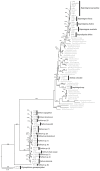Evaluation of Potential Transfer of the Pathogen Saprolegnia parasitica between Farmed Salmonids and Wild Fish
- PMID: 34451390
- PMCID: PMC8398048
- DOI: 10.3390/pathogens10080926
Evaluation of Potential Transfer of the Pathogen Saprolegnia parasitica between Farmed Salmonids and Wild Fish
Abstract
Saprolegnia infections are among the main parasitic diseases affecting farmed salmonids. The distribution and potential transfer of Saprolegnia spp. between farms and the natural environment has been scarcely investigated. Therefore, this work aimed to study the diversity and abundance of oomycete species in salmonid farms, tributary water, and effluent water systems. Four trout farms in Italy and two Atlantic salmon farms in Scotland were considered. In Italian farms, 532 isolates of oomycetes were obtained from fish and water, at upstream, inside, and downstream the farms. In Scottish farms, 201 oomycetes isolates were obtained from water outside the farm and from fish and water inside the farming units. Isolates were identified to the species level through amplification and sequencing of the ITS rDNA region. In Italy, S. parasitica was significantly more present in farmed than in wild fish, while in water it was more frequently isolated from the wild, particularly in effluent systems, not associated with more frequent isolation of S. parasitica in wild fish downstream the farm. In Scotland, S. parasitica was the most prevalent species isolated from fish, while isolates from water were mostly Pythium spp. with few S. parasitica isolates from upstream and downstream the farms.
Keywords: Italy; Oncorhynchus mykiss; Salmo marmoratus; Salmo salar; Salmo trutta; Saprolegnia parasitica; Scotland; salmonid farms.
Conflict of interest statement
The authors declare no conflict of interest. The funders had no role in the design of the study; in the collection, analyses, or interpretation of data; in the writing of the manuscript, or in the decision to publish the results.
Figures







References
-
- Johansen L.H., Jensen I., Mikkelsen H., Bjørn P.A., Jansen P.A., Bergh Ø. Disease interaction and pathogens exchange between wild and farmed fish populations with special reference to Norway. Aquaculture. 2011;315:167–186. doi: 10.1016/j.aquaculture.2011.02.014. - DOI
-
- Krkošek M. Host density thresholds and disease control for fisheries and aquaculture. Aquac. Environ. Int. 2010;1:21–32. doi: 10.3354/aei0004. - DOI
Grants and funding
LinkOut - more resources
Full Text Sources
Miscellaneous

